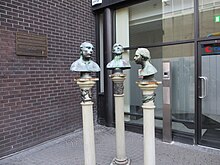Abbey Street
History
Abbey Street was named after the former St Mary's Abbey, which was located in the area from 1139 until 1539. The street first appeared on maps of Dublin in 1728. On John Rocque's 1756 map, the street is divided into Great Abbey Street and Little Abbey Street.
Notable addresses
The remnants of St Mary's Abbey are accessible on Meetinghouse Lane, off Mary's Abbey.
The National Theatre of Ireland, the Abbey Theatre is located on Abbey Street Lower, and its building also incorporates the basement Peacock Theatre. The Royal Hibernian Academy building used to be located in Abbey Street Lower but was destroyed in 1916. In 1900, Maud Gonne founded Inghinidhe na hÉireann (The Daughters of Erin) at 32 Abbey Street Lower.
The former headquarters of Independent News & Media and its Irish Independent newspaper, 'Independent House,' is located on Abbey Street Middle, although the offices have since moved to nearby Talbot Street. Independent House had previously been the offices of The Nation, a nationalist newspaper.
George Frideric Handel stayed in Abbey Street while in Dublin producing Messiah at Fishamble Street in 1742. In 1785, James Napper Tandy stayed at 180 Abbey Street before eventually fleeing to the United States.
Retail & services

Notable establishments include:
- Arnotts department store, although its main entrance is on Henry Street
- The Jervis shopping centre, as of 2008, the largest shopping centre in Dublin city centre
- The Academy music venue, formerly Spirit nightclub, 57 Abbey Street Middle
- Eason book and stationery shop (its main entrance is on O'Connell Street)
- Abbey Street Methodist Church where Australian politician, William McMillan lived in his youth.
- The Irish Life Centre, a prominent mixed-use complex on Abbey Street Lower, including office space, parts occupied by Irish Life itself
- The National Lottery offices are part of the Irish Life Centre
- Wynn's Hotel, Dublin, a period hotel which has featured in a number of important Irish literary works.
See also
References
- ^ Clerkin, Paul (2001). Dublin street names. Dublin: Gill & Macmillan. pp. 1–2. ISBN 0-7171-3204-8. OCLC 48467800.
- ^ M'Cready, C. T. (1987). Dublin street names dated and explained. Blackrock, Co. Dublin: Carraig. p. 1. ISBN 1-85068-005-1. OCLC 263974843.
- ^ Peter M. Gunnar (1995). Good Iron Mac: The Life of Australian Federation Father Sir William McMillan, K.C.M.G. Federation Press. pp. 2–. ISBN 978-1-86287-176-2. Retrieved 25 May 2013.